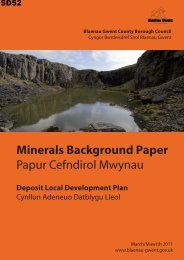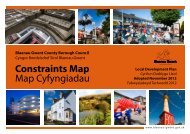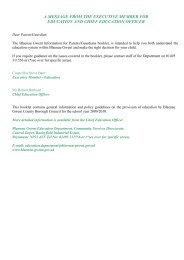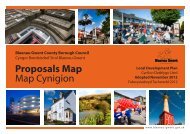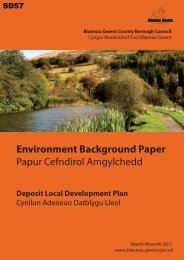Planning Policy Wales - Brecon Beacons National Park
Planning Policy Wales - Brecon Beacons National Park
Planning Policy Wales - Brecon Beacons National Park
You also want an ePaper? Increase the reach of your titles
YUMPU automatically turns print PDFs into web optimized ePapers that Google loves.
13.12.3 <strong>Planning</strong> authorities may use planning conditions or obligations to meet planning aims to<br />
protect the environment where these are pertinent to the development proposed. It is important for<br />
planning authorities to understand the scope and purpose of conditions that can be imposed by<br />
pollution authorities so as to ensure that planning conditions neither duplicate nor conflict with such<br />
conditions. Proposed development should be designed wherever possible to prevent adverse effect<br />
to the environment but as a minimum to limit or constrain any effects that do occur.<br />
13.13 Reducing noise and light pollution<br />
13.13.1 Noise can affect people’s health and well-being and have a direct impact on wildlife and<br />
local amenity. Noise levels provide an indicator of local environmental quality. The objective of a<br />
policy for noise is to minimise emissions and reduce ambient noise levels to an acceptable standard.<br />
Noise Action Plans, drawn up by the Welsh Ministers in relation to <strong>Wales</strong> under the Environmental<br />
Noise Directive, and the <strong>Wales</strong> Regulations 17 , aim to prevent and reduce environmental noise<br />
where necessary and preserve environmental noise quality where it is good. They are a planning<br />
consideration in the use and development of land.<br />
13.13.2 There is a need to balance the provision of lighting to enhance safety and security to<br />
help in the prevention of crime and to allow activities like sport and recreation to take place with the<br />
need to:<br />
• protect the natural and historic environment including wildlife;<br />
• retain dark skies where appropriate;<br />
• prevent glare and respect the amenity of neighbouring land uses 18 ; and<br />
• reduce the carbon emissions associated with lighting.<br />
Lighting to provide security can be particularly important in rural areas (see 4.10.12).<br />
13.14 Development plans and noise and lighting 19<br />
13.14.1 Development plan policies should be designed to ensure, as far as is practicable, that<br />
noise-sensitive developments, such as hospitals, schools and housing, that need to be located close<br />
to the existing transportation infrastructure to facilitate access, are designed in such a way as to<br />
limit noise levels within and around those developments. Such development should be located away<br />
from existing sources of significant noise including air transport and some industrial activities or<br />
programmed development such as improved or new roads. Policies should also be designed to<br />
ensure, as far as possible, that potentially noisy developments are located in areas where noise<br />
will not be such an important consideration or where its impact can be minimised. Local planning<br />
authorities should adopt policies to prevent potentially noisy developments in areas which have<br />
remained relatively undisturbed by noise. Development plan policies should have regard to any<br />
relevant Noise Action Plan, including the need to protect urban ‘quiet areas’ against an increase<br />
in noise.<br />
190<br />
<strong>Planning</strong> <strong>Policy</strong> <strong>Wales</strong> Edition 3 - July 2010 - Chapter 13 Minimising and Managing Environmental<br />
Risks and Pollution


